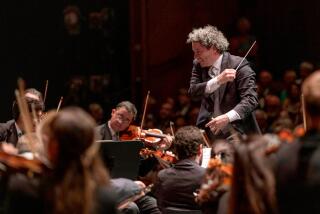Bonn, Germany: Embracing the city and its musical genius
Ever since my mom gave me the complete works of Ludwig van Beethoven — the best birthday present I ever got — I’d wanted to make a pilgrimage to Bonn, the composer’s birthplace, to soak up the atmosphere and look for clues to his genius.
Forty years later, I finally showed up. Bonn, in northwestern Germany, is way off the beaten tourist track, but I’m glad I made the effort. I spent four days in May absorbing Beethoven’s legacy, the city’s friendly ambience, Rhine River vistas and liberal quantities of Riesling wine and kolsch, as the local beer is called.
I didn’t come close to unlocking the mystery of Ludwig’s talent — but loved my visits to the Beethoven-Haus birthplace and museum, the world’s leading repository of his handwritten scores, letters and personal effects, including many of his musical instruments, portraits and keepsakes.
Secreted away in a vault below the museum are more than 1,000 manuscripts of his compositions, about a third of those known to exist. The most recent addition is the score for the “Diabelli Variations,” Beethoven’s last piano masterpiece.
The museum bought the manuscript in 2009 for an undisclosed price that must have been steep: It took five years of benefit performances by renowned musicians, including pianists Daniel Barenboim, Rudolf Buchbinder and Alfred Brendel, and violinist Anne-Sophie Mutter to raise the money to finance it.
All those scores, plus 500 letters Beethoven wrote, have been digitized and are available for viewing on the museum’s website.
I liked Bonn so much that I’ve promised myself a return visit for the annual Beethovenfest, a four-week, 60-concert binge for Ludwig freaks that starts Sept. 9. The festival has made its name by giving Beethoven’s music fresh perspective and by presenting new faces, among them current L.A. Philharmonic music director Gustavo Dudamel.
In 2004, when still an unknown, the Dude was tapped by Beethovenfest director Ilona Schmiel as a last-minute replacement to lead the London-based powerhouse Philharmonia Orchestra. It was an important step on Dudamel’s way to stardom, and he hasn’t forgotten the favor: He’s returned three times to conduct.
Monument to the man
I approached the house where Beethoven was born in 1770 as one would a holy shrine. It had survived the World War II bombing that had leveled one-third of Bonn’s inner core. Although the Beethoven family vacated the house when the composer was 3 and Beethoven spent most of his creative life in Vienna, the building has been the principal monument to the composer since 1889, when a foundation was formed to buy and maintain it.
The second floor is dedicated to permanent and temporary exhibits, and there are treasures in every room, including the two violins, viola and cello on which Beethoven composed his final string quartets, my favorite works. There are several portraits of Beethoven and a haunting plaster life mask cast in 1812 by sculptor Franz Klein.
In one showcase are the ear trumpets he used to aid his hearing. Opposite it is the piano he owned at his death in 1827. On one wall is the portrait of his musician grandfather, also named Ludwig, that he carried everywhere, through his many moves in Vienna, often one step ahead of rent-seeking landlords.
Although the museum has been collecting Beethoven’s personal effects since it was established, more than half of them came from the estate of Swiss industrialist Hans Conrad Bodmer, who spent 40 years amassing Beethoveniana and who bequeathed his collection to the museum on his death in 1956.
Among several letters on view during my visit were those Beethoven wrote to a publisher haggling over the fee for his great choral work “Missa Solemnis.”
There is more to Bonn’s musical heritage than Beethoven. Composer Robert Schumann was committed to a mental institution here, where he died in 1856. Partly destroyed by Allied bombing, the rebuilt sanitarium is now a state library and houses a small
collection of Schumann’s letters and personal effects. Occasional concerts are also held there.
Schumann and his wife, Clara, a renowned pianist, are buried in the Old Cemetery beneath a tomb partly paid for by composer Johannes Brahms.
Bonn, a one-time Roman colony with a population of 300,000, played a crucial role in Germany’s post-World War II history. It was West Germany’s capital from 1949 until after the Berlin Wall came down in 1989 and most of the country’s bureaucracy moved to Berlin.
But it still feels vibrant. Six of 16 ministries are still based here, as are most international agencies, including the United Nations. In fact, Bonn’s population has grown in the last 15 years, buoyed by students and retired bureaucrats and military attracted to its relatively mild climate and cultural amenities.
But it wasn’t contemporary German history that brought me here; it was the 40-year-old promise that I had made to myself — one that I finally kept and in so doing deepened my love and understanding for the great master’s music.
More to Read
Sign up for The Wild
We’ll help you find the best places to hike, bike and run, as well as the perfect silent spots for meditation and yoga.
You may occasionally receive promotional content from the Los Angeles Times.






